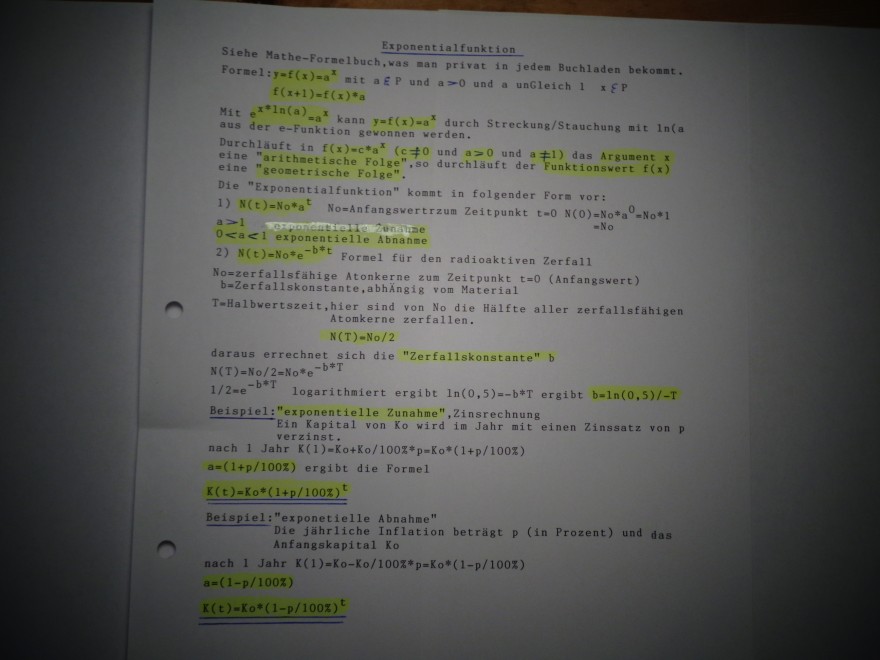f(x)=b*a^(x)
K(t)=Ko*a^(t)
Ko=1000 € Kapitel bei t=0 → K(0)=Ko*a⁰=Ko*1=Ko
p=0,5 %
K(1)=Ko+Ko/100%*0,5%)Ko*(1+0,5%/100%)=Ko*(1+0,005)
a=1+p/100%=1,005 → exponentielle Zunahme
K(t)=1000 €*1,05^(t)
p=-0,5%
K(1)=Ko-Ko/100%*0,5%=Ko*(1-0,5%/100%)=Ko*(1-0,005)
a=1-p/100%=1-0,005=0,995 → exponentielle Abnahme
K(t)=1000 €*0,995^(t)
t=10 Jahre bei p=0,5% Deutschland
K(10)=1000 €*1,0051⁰=1051,14 €
t=10 Jahre in Italien
K(10)=1000 €*0,9951⁰=951,11 € Velust Inflation
Den Rest schaffst du selbera=1-p/100%=1-0,005=0,995
Text erkannt:
Siehe Mathe-Forme1buch,was man privat in jedem Buchladen bekommt. Formel: y=f(x)=ax mit a EP und a>0 und a unGleich 1 x 5 p f(x+1)=f(x)∗a
Mit ex∗ln(a)=ax kann y=f(x)=ax durch Streckung/S tauchung mit ln(a
aus der e-Funktion gewonnen werden. Durchläuft in f(x)=c∗ax(c=0 und a>0 und a=1) das Argument x eine "arithmetische Folge", so durchlauft der Funktionswert f(x) afno n eine "geometrische Folge" Die "Exponentialfunktion" kommt in folgender Form vor:
1) N(t)=N0⋅at No=Anfangswertrzum Zeit punkt t=0N(0)=N0=a0=N0∗1
2) N(t)=N0∗e−b∗t Formel fúr den radioaktiven Zerfall No=zerfallsfahige Atonkerne zum Zeitpunkt t=0 (Anfangswert) b= Zerfallskonstante, abhAngig vom Materia. T=Halbwertszeit, hier sind von No die Hälfte aller zerfallsfähigen Atomkerne zerfallen. N(T)=No/2
daraus errechnet sich die "Zerfallskonstante" b N(T)=No/2=No∗
1/2=e−b∗ T logarithmiert ergibt ln(0,5)=−b∗ T ergibt b=ln(0,5)/−T
nach 1 Jahr K(1)=K0+K0/100%∗p=K0∗(1+p/100%)
a=(1+p/100%) ergibt die Forme1
K(t)=K0∗(1+p/100%)t
Beispiel: "exponetielle A bnahme" Anfangskapital Ko nach 1 Jahr K(1)=K0−K0/100%∗p=K0∗(1−p/100%)
a=(1−p/100z)
K(t)=Ko∗(1−p/100q)t
Plotlux öffnen f1(x) = 1000·1,005xf2(x) = 1051Zoom: x(-2…15) y(800…1100)x = 10